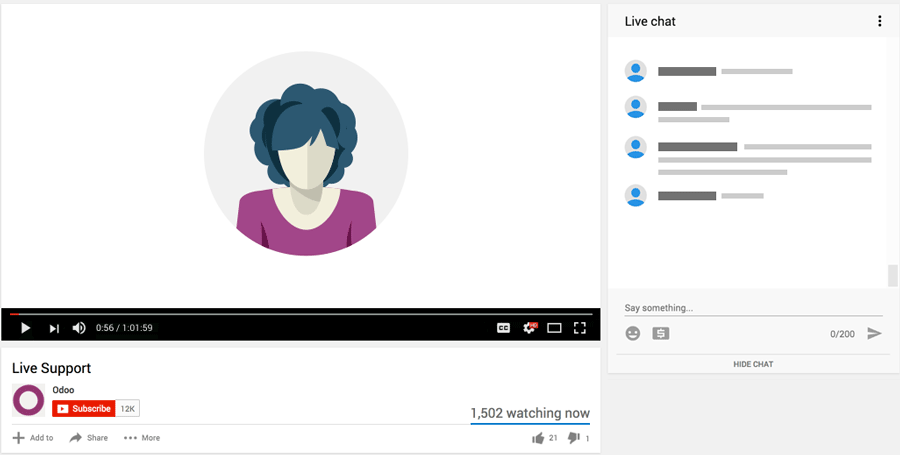I like to challenge the community to think about how a headless CMS for Odoo looks like. How can the Website and the E-commerce app function without a head? Would this be possible on Odoo.sh? What techniques could be used like PostgreSQL, Elasticsearch, NodeJS, CDN, load balancing, React.
We are in the early stages of developing an Odoo ecommerce platform. We discover Odoo website V14 is yet slow compared with custom made ecommerce platforms like bestbuy.com. The Lighthouse or Google Pagespeed Insights show a fairly low score For mobile between 20 and 60 on a 100 scale . For now maybe this is okay. But we would like Odoo to become a lightening fast e-commerce platform in the future . The techniques are there already there. Is it possible for the Odoo platform to become lightning fast? How is it possible for Odoo to become that fast. I think a headless mode can be the answer. What do you think?
(In my investigation I also found steersman.works build Odoo on top of AWS. Although it's not a real headless platform they are already able to build a lightning fast e-commerce platform like legionsafety.com
Odoo is the world's easiest all-in-one management software.
It includes hundreds of business apps:
- CRM
- e-Commerce
- Buchhaltung
- Lager
- PoS
- Project
- MRP
Diese Frage wurde gekennzeichnet
Thank you for your answers. Thanks to "Lille Butik GmbH" we found the "Vue Storefront Odoo" solution. In the meanwhile we developed websites based on this open source platform: https://github.com/vuestorefront-community/odoo
Our websites based on this platform:
https://www.gevenhout.nl
https://www.gevenholz.de
Please let me know if you have any question about our implementation.
Hello,
There are two parts to your question. Let us try to answer them sequentially -
Question 1. How Odoo e-commerce can be made headless and which major components the architecture should have?
In order to implement headless architecture with Odoo, we can select one of the already established and popular headless frameworks like React, Vue, Vue Storefront, etc.
For instance, if we take Vue Storefront as the headless front end. The system can then utilize Odoo's PostgreSQL database as the database for storing data, Elasticsearch for advanced search capabilities, and Node.js as the backend for Vue Storefront.
In this case, the Vue Storefront, built with Vue.js, will serve as the fast and flexible front-end, communicating with Odoo's backend through API calls. Additionally, React components can be integrated into Vue Storefront for specific functionalities, if needed.
To ensure high performance and availability, the architecture can also include a Content Delivery Network (CDN) to cache and distribute static assets globally. Furthermore, load balancing will be implemented to distribute client requests across multiple application servers efficiently.
In summary, this architecture can foster a decoupled and scalable e-commerce platform, utilizing the strengths of each component to deliver an outstanding user experience.
This architecture and various other similar architectures can be implemented on both the Odoo community, enterprise (self-hosted), and on Odoo.sh as well.
We have expertise in developing and implementing headless for the Odoo platform and more details on the approach and technology used, can be found here - https://webkul.com/odoo-headless-development/
Question 2. How can Odoo e-commerce perform better in terms of its speed? and what are the different ways through which we can make Odoo e-commerce perform at lightning-fast speed?
Although, with the later versions (especially the most recent one, Odoo 16), Odoo has significantly improved it's overall performance and speed. Still, there are various ways, through which we can further improve the overall speed and performance of the Odoo Website with different ways.
Essentially, the speed optimization can be further divided into three different parts -
A) Odoo's Website Structure Improvement - Here we work on several website KPIs like TTFB, Time to interact, First contentful point, onload time, full loading time, where the images are in recommended format, etc.
B) Odoo Backend Optimization - Step A, as described above, is related to the front end, and in the second step, analysis of the back end is done to check if there is any module that is poorly coded leading to the website performance issues.
C) Server Optimization - This is essentially ensuring that we have the right server architecture in place and if there is a need to tune up the server specifications or add more components and processes to the existing architecture like a load balancer, having elastic server implemented to bring lightening fast search results, having redis to enhance the overall session management (https://store.webkul.com/odoo-redis-session-store.html)
We have also created a headless e-commerce solution for Odoo using React NextJS for the front end and it is connected with Odoo using Custom Rest APIs. Check it out here -
https://store.webkul.com/odoo-headless-e-commerce.html
Regards,
Team Webkul
You might be interested \https://www.odoogap.com/blog/odoogap-blog-1/vuestorefront-odoo-integration/
Diskutieren Sie gerne? Treten Sie bei, statt nur zu lesen!
Erstellen Sie heute ein Konto, um exklusive Funktionen zu nutzen und mit unserer tollen Community zu interagieren!
Registrieren| Verknüpfte Beiträge | Antworten | Ansichten | Aktivität | |
|---|---|---|---|---|
|
|
2
Juli 24
|
1869 | ||
|
|
0
Feb. 23
|
826 | ||
|
|
2
Nov. 24
|
242 | ||
|
|
1
Juni 21
|
4080 | ||
|
|
3
Mai 20
|
13103 |

